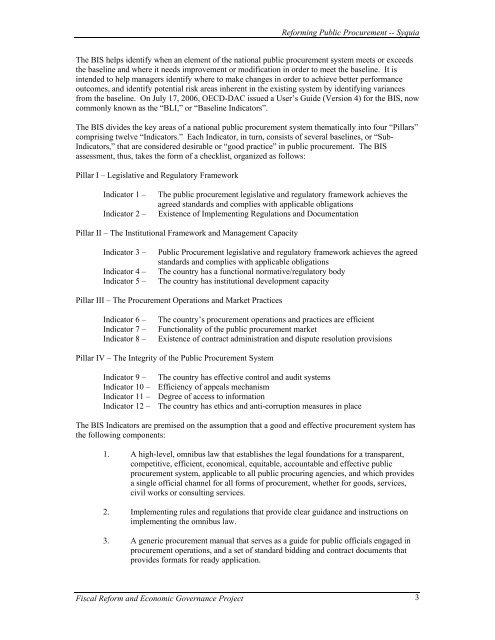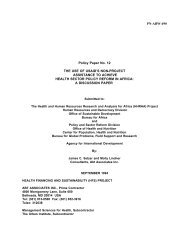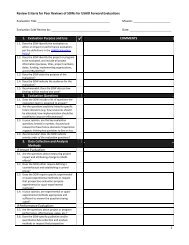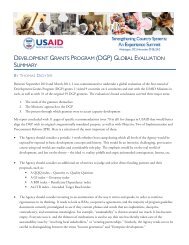Reforming Public Procurement in Emerging Market ... - KDID Portal
Reforming Public Procurement in Emerging Market ... - KDID Portal
Reforming Public Procurement in Emerging Market ... - KDID Portal
You also want an ePaper? Increase the reach of your titles
YUMPU automatically turns print PDFs into web optimized ePapers that Google loves.
<strong>Reform<strong>in</strong>g</strong> <strong>Public</strong> <strong>Procurement</strong> -- Syquia<br />
The BIS helps identify when an element of the national public procurement system meets or exceeds<br />
the basel<strong>in</strong>e and where it needs improvement or modification <strong>in</strong> order to meet the basel<strong>in</strong>e. It is<br />
<strong>in</strong>tended to help managers identify where to make changes <strong>in</strong> order to achieve better performance<br />
outcomes, and identify potential risk areas <strong>in</strong>herent <strong>in</strong> the exist<strong>in</strong>g system by identify<strong>in</strong>g variances<br />
from the basel<strong>in</strong>e. On July 17, 2006, OECD-DAC issued a User’s Guide (Version 4) for the BIS, now<br />
commonly known as the “BLI,” or “Basel<strong>in</strong>e Indicators”.<br />
The BIS divides the key areas of a national public procurement system thematically <strong>in</strong>to four “Pillars”<br />
compris<strong>in</strong>g twelve “Indicators.” Each Indicator, <strong>in</strong> turn, consists of several basel<strong>in</strong>es, or “Sub-<br />
Indicators,” that are considered desirable or “good practice” <strong>in</strong> public procurement. The BIS<br />
assessment, thus, takes the form of a checklist, organized as follows:<br />
Pillar I – Legislative and Regulatory Framework<br />
Indicator 1 –<br />
Indicator 2 –<br />
The public procurement legislative and regulatory framework achieves the<br />
agreed standards and complies with applicable obligations<br />
Existence of Implement<strong>in</strong>g Regulations and Documentation<br />
Pillar II – The Institutional Framework and Management Capacity<br />
Indicator 3 –<br />
Indicator 4 –<br />
Indicator 5 –<br />
<strong>Public</strong> <strong>Procurement</strong> legislative and regulatory framework achieves the agreed<br />
standards and complies with applicable obligations<br />
The country has a functional normative/regulatory body<br />
The country has <strong>in</strong>stitutional development capacity<br />
Pillar III – The <strong>Procurement</strong> Operations and <strong>Market</strong> Practices<br />
Indicator 6 –<br />
Indicator 7 –<br />
Indicator 8 –<br />
The country’s procurement operations and practices are efficient<br />
Functionality of the public procurement market<br />
Existence of contract adm<strong>in</strong>istration and dispute resolution provisions<br />
Pillar IV – The Integrity of the <strong>Public</strong> <strong>Procurement</strong> System<br />
Indicator 9 – The country has effective control and audit systems<br />
Indicator 10 – Efficiency of appeals mechanism<br />
Indicator 11 – Degree of access to <strong>in</strong>formation<br />
Indicator 12 – The country has ethics and anti-corruption measures <strong>in</strong> place<br />
The BIS Indicators are premised on the assumption that a good and effective procurement system has<br />
the follow<strong>in</strong>g components:<br />
1. A high-level, omnibus law that establishes the legal foundations for a transparent,<br />
competitive, efficient, economical, equitable, accountable and effective public<br />
procurement system, applicable to all public procur<strong>in</strong>g agencies, and which provides<br />
a s<strong>in</strong>gle official channel for all forms of procurement, whether for goods, services,<br />
civil works or consult<strong>in</strong>g services.<br />
2. Implement<strong>in</strong>g rules and regulations that provide clear guidance and <strong>in</strong>structions on<br />
implement<strong>in</strong>g the omnibus law.<br />
3. A generic procurement manual that serves as a guide for public officials engaged <strong>in</strong><br />
procurement operations, and a set of standard bidd<strong>in</strong>g and contract documents that<br />
provides formats for ready application.<br />
Fiscal Reform and Economic Governance Project 3







